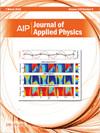Invited Article: The oxidation kinetics and mechanisms observed during ultra-high temperature oxidation of (HfZrTiTaNb)C and (HfZrTiTaNb)B2
IF 2.7
3区 物理与天体物理
Q2 PHYSICS, APPLIED
引用次数: 0
Abstract
Ultra-high temperature ceramics (UHTCs), most notably transition metal carbides and borides, exhibit melting temperatures exceeding 3000 °C, making them appropriate candidates to withstand the extreme temperatures (∼2000 °C) expected to occur at the leading edges of hypersonic vehicles. However, their propensity to react rapidly with oxygen limits their sustained application. The high entropy paradigm enables the exploration of novel UHTC compositions that may improve on the oxidation resistance of conventional refractory mono-carbides and -diborides. The oxidation kinetics of candidate high entropy group IV + V (HfZrTiTaNb)C and (HfZrTiTaNb)B2 materials were evaluated at 1500–1800 °C using Joule heating in one atmosphere 0.1%–1% oxygen/argon gas mixtures for times up to 15 min. Possible mechanisms based on the resulting complex time, temperature, and oxygen partial pressure dependencies are discussed. The carbides formed porous and intergranular oxides. Oxidation resistance was improved upon a continuous external scale formation. The diborides formed dense external scales and exhibited better oxidation resistance compared to the carbides. This improvement was attributed to the formation of liquid boria. Both compositions showed an unexpected reduction in material consumption at 1800 °C for all times tested, compared to results at lower temperatures. An in-depth analysis of the composition and morphology of the oxide scale and sub-surface regions for specimens tested at 1800 °C revealed that the formation of denser group IV-rich (Hf, Zr, Ti) oxides mitigated the formation of the otherwise detrimental liquid-forming group V (Ta, Nb) oxides, leading to the improved oxidation resistance.特邀文章:(HfZrTiTaNb)C和(HfZrTiTaNb)B2的超高温氧化过程中观察到的氧化动力学和机制
超高温陶瓷(UHTC),主要是过渡金属碳化物和硼化物,熔化温度超过 3000 ℃,因此适合承受高超音速飞行器前缘的极端温度(2000 ℃)。然而,它们与氧气发生快速反应的倾向限制了它们的持续应用。高熵范例使人们能够探索新型超高真空技术成分,从而提高传统难熔单碳化物和二硼化物的抗氧化性。在 1500-1800 °C的温度下,在 0.1%-1% 氧气/氩气混合物中使用焦耳加热法评估了候选高熵 IV + V 组 (HfZrTiTaNb)C 和 (HfZrTiTaNb)B2 材料的氧化动力学,时间最长达 15 分钟。根据由此产生的复杂的时间、温度和氧分压依赖关系,讨论了可能的机制。碳化物形成了多孔和晶间氧化物。持续的外部鳞片形成提高了抗氧化性。与碳化物相比,二硼化物形成了致密的外部鳞片,表现出更好的抗氧化性。这种改善归因于液态硼化物的形成。与较低温度下的结果相比,这两种成分在 1800 °C 的所有测试时间内都意外地减少了材料消耗。对在 1800 °C下测试的试样的氧化鳞片和次表面区域的成分和形态进行深入分析后发现,富含IV族(Hf、Zr、Ti)的高密度氧化物的形成减轻了原本不利于形成液态的V族(Ta、Nb)氧化物的形成,从而提高了抗氧化性。
本文章由计算机程序翻译,如有差异,请以英文原文为准。
求助全文
约1分钟内获得全文
求助全文
来源期刊

Journal of Applied Physics
物理-物理:应用
CiteScore
5.40
自引率
9.40%
发文量
1534
审稿时长
2.3 months
期刊介绍:
The Journal of Applied Physics (JAP) is an influential international journal publishing significant new experimental and theoretical results of applied physics research.
Topics covered in JAP are diverse and reflect the most current applied physics research, including:
Dielectrics, ferroelectrics, and multiferroics-
Electrical discharges, plasmas, and plasma-surface interactions-
Emerging, interdisciplinary, and other fields of applied physics-
Magnetism, spintronics, and superconductivity-
Organic-Inorganic systems, including organic electronics-
Photonics, plasmonics, photovoltaics, lasers, optical materials, and phenomena-
Physics of devices and sensors-
Physics of materials, including electrical, thermal, mechanical and other properties-
Physics of matter under extreme conditions-
Physics of nanoscale and low-dimensional systems, including atomic and quantum phenomena-
Physics of semiconductors-
Soft matter, fluids, and biophysics-
Thin films, interfaces, and surfaces
文献相关原料
| 公司名称 | 产品信息 | 采购帮参考价格 |
|---|
 求助内容:
求助内容: 应助结果提醒方式:
应助结果提醒方式:


